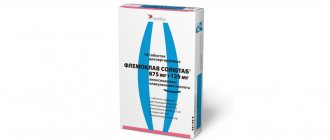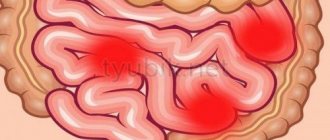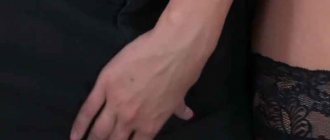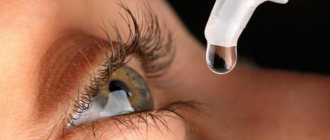Pharmacodynamics and pharmacokinetics
Pharmacodynamics
Furazolidone is an antimicrobial agent derived from nitrofuran . Salmonella , Shigella , Campylobacter , as well as protozoa ( Giardia , Trichomonas ) and Vibrio cholerae are highly sensitive to it . Depending on the concentration, it has a bactericidal or bacteriostatic effect.
The mechanism of action is the blockade of many enzyme systems of the microorganism. Nitrofurans disrupt cellular respiration, suppress the Krebs cycle and block the biosynthesis of nucleic acids. As a result, the shell of microorganisms or their cytoplasmic membrane is destroyed. When the drug acts, destroyed microbial cells release less toxins. Unlike other antimicrobial agents, they activate the immune system.
Acts on strains resistant to some antibiotics. Does not affect anaerobes and Pseudomonas aeruginosa . Resistance of microorganisms to the drug occurs rarely.
What is Furazolidone used for? Since it is poorly absorbed from the gastrointestinal tract and high concentrations are created in the intestine, it is used for intestinal infections of bacterial and protozoal etiology. Unlike Furadonin, it is characterized by low toxicity.
Pharmacokinetics
Well absorbed when taken orally. Distributed in tissues and liquids. In the cerebrospinal fluid during meningitis , the same concentrations are created as in the plasma; therapeutic concentrations are also achieved in the intestinal lumen. Intensively metabolized in the liver to an inactive metabolite. Excreted by the kidneys (up to 65%), small amounts are determined in feces,
Operating principle and description
Furazolidone is a yellow, flat-cylindrical tablet.
| Compound | |
| furazolidone | 0.05 g |
| potato starch | 0.02 g |
| calcium stearate | 0.001 g |
| sucrose | 0.01 g |
| polysorbate | 0.0002 g |
| lactose | 0.0188 g |
Furazolidone inhibits pathogenic organisms by affecting the process of cellular respiration, blocks the cyclic biochemical process in the cell, disrupts the biosynthesis of membrane proteins and the activity of respiratory enzymes.
The priority substance of the drug has the property of slowing down the reproduction and growth of bacteria or completely eliminating their vital activity, depending on the dosage.
It affects a whole range of gram-negative bacteria (streptococci, staphylococci, rod-shaped, spore-forming) and some gram-positive bacteria (Trichomonas, giardia). Active when interacting with microorganisms resistant to sulfonamides and antibiotics. It has little effectiveness against pathogens of toxic and pyogenic infections.
The drug is well absorbed, penetrates into tissues, and is excreted with the secretions of intestinal glands and bile. Maximum activity remains in the blood for 5-6 hours. It is excreted from the body mainly by the kidneys and also by the intestines.
Side effects
- skin rash, skin itching, Quincke's edema ;
- decreased appetite;
- pulmonary edema , bronchospasm (with long-term use);
- nausea, vomiting;
- hepatotoxic effect;
- neuritis (with long-term use).
The risk of peripheral neuropathy increases with diabetes mellitus , hypovitaminosis B and C , and anemia .
Dangers and risks associated with treatment with Furazolidone
Treatment with Furazolidone may be accompanied by some undesirable reactions of the body:
- problems with the absorption and digestion of food (decreased appetite, nausea, vomiting);
- allergic manifestations (rash, redness and itching of the skin, angioedema).
A significant drawback of the drug is that adverse reactions during treatment with it occur quite often, and with long-term use the risk of the formation of tumors in the kidneys increases.
Furazolidone is contraindicated in the following cases:
- increased individual sensitivity to the group of nitrofurans;
- end-stage chronic renal failure;
- deficiency of glucose-6-phosphate dehydrogenase;
- children under 3 years of age.
In addition, the drug may be dangerous for diseases of the kidneys, liver and nervous system.
If any occur, then treatment with Furazolidone is carried out with caution.
Taking excessive doses results in a multiple increase in the toxic effect of the active substance of the drug on the liver and nervous system, which leads to the occurrence of polyneuritis and acute toxic hepatitis. In case of overdose, the tablets are canceled, symptomatic treatment is carried out, B vitamins and antihistamines are prescribed along with drinking a large volume of liquid.
Furazolidone and other drugs
Before starting furazolidone therapy, you need to inform your doctor about all medications that your child is taking. This need is dictated by the fact that the active substance of the tablets, when taken simultaneously with a number of medications, can negatively affect the health of a small patient.
- Furazolidone in combination with ethanol leads to the development of a disulfiram-like reaction - a condition in which acute intoxication of the body occurs, accompanied by headache, nausea, vomiting, fever, difficulty breathing, cardiac arrhythmia, and a feeling of fear.
- The antibiotic is incompatible with antidepressants and monoamine oxidase inhibitors. Its use with phenylephrine, used as a vasoconstrictor in pediatrics, can cause a sharp increase in blood pressure.
- Tetracycline, antibiotics belonging to the group of aminoglycosides, and protein foods enhance the antimicrobial properties of Furazolidone.
- Medicines and foods that alkalize urine, for example, mineral complexes, accelerate the excretion of Furazolidone through the kidneys, that is, they reduce its effectiveness.
Furazolidone tablets, instructions for use (Method and dosage)
The drug is taken orally, after meals, as it can cause dyspeptic disorders. The tablets should be taken with a glass of water.
With long-term use for the purpose of preventing neuritis , it is combined with taking B vitamins .
Instructions for use of Furazolidone
The dose for adults for paratyphoid fever , dysentery and food poisoning is 0.1 g per day 4 times a day for 5–10 days. Single dose - 0.2 g, daily dose - 0.8 g.
For giardiasis - 0.1 g 4 times a day for up to 7 days, after a week the same course is repeated.
For trichomonas urethritis - 0.1 g 4 times for 3 days.
For trichomonas colpitis, the dosage and frequency of administration are the same and in parallel, a powder containing furazolidone and milk sugar is injected into the vagina, and suppositories containing 4-5 mg of furazolidone are administered into the rectum.
For the treatment of burns locally in the form of bandages with a solution of the drug (1:25000).
Instructions for use for children
For children, the dose is calculated per kg of body weight. It is: one-time - 0.0025 g per kg, and daily 0.01 g per kg, distributed over 3-4 doses. The course of treatment is 5-7 days.
Application in veterinary medicine
The veterinary drug is a yellow powder, insoluble in water.
The drug is used for: salmonellosis , coccidiosis , colibacillosis , enteritis , balantidiasis in animals and birds. You can also use a pharmaceutical drug in tablets (one tablet contains 50 mg).
The dosage for these diseases is the same for chickens, turkey poults and broilers - the drug is added to the feed at the rate of 3 mg per head 2 times a day, treatment is carried out for 8 days. If necessary, the course of treatment is repeated, but after a break of 10 days. As a preventative measure, young animals up to 10 days of age are given 2 mg per head once a day.
An overdose is unacceptable, since the bird becomes drowsy, lethargic and may die. How to feed to chickens? Better with food. Another option is to dissolve it in water and give it as a drink. But you need to know that the drug does not dissolve well and loses its properties when exposed to sunlight.
Interaction
Aminoglycosides and Tetracycline enhance its antimicrobial effect.
Antidepressants, phenylephrine , ephedrine , MAO inhibitors, tyramine , amphetamine in combination with furadonine cause a significant increase in blood pressure.
Agents that alkalize urine reduce the effect of the drug.
Inhibition of hematopoiesis increases when used with chloramphenicol and Ristomycin .
Incompatible with alcohol, as this combination causes disulfiram-like reactions.
Interaction with drugs.
For some diseases, combination with other medications helps. For cystitis, Drotaverine and Nimesulide are added. For pyelitis it is necessary to combine it with antibiotics. Aminoglycosides and tetracycline enhance antimicrobial properties.
Contraindicated in combination with the following medications:
- Uronephron, Magurlit, Urodan. Reduce the effectiveness of inhibition of microbes and bacteria.
- Adepress, Profluzac, Prozac, Garmaline. Increases blood pressure.
- Sintomycin, Ristomycin. Negative effect on the process of hematopoiesis. Tyramine. The combination can cause your blood pressure to spike.
If Furazolidone tablets are taken for several days or more, it is necessary to limit some foods: cheese, kefir, yogurt, chocolate, canned food. These products contain the organic substance tyramine.
Drinking alcohol while taking Furazolidone is not allowed!
The need to take a course of medication depends on the type of pathogenic microorganisms. Some bacteria are inhibited by other antimicrobial and antibacterial agents. If you have any diarrhea, you should not immediately start taking Furazolidone. In most cases, treatment begins with probiotics.
Furazolidone for children
The instructions for children provide the following indications for use: amoebic dysentery , salmonellosis , giardiasis .
How to give Furazolidone to children?
A convenient form of release for children is in the form of granules, from which a suspension is prepared by adding 100 ml of water. When properly prepared, 1 ml of suspension will contain 0.0003 g of the drug. The suspension is used 4 times a day, measuring with a measuring cup and used until 7 years of age. A single dose is: 1-2 years, 4-5 ml, 3-4 years, 6-7 ml, 4-5 years, 7.5-8.5 ml.
From the age of 7, children can already take pills. The dosage of tablets for children is correspondingly less than for adults. At the age of 7-14 years, a single dose of 0.03-0.05 g is recommended, a daily dose of 0.12 g-0.15 g.
Reviews from parents indicate its effectiveness in intestinal infections:
- “... We took Bifiform and Enterofuril - nothing helped. I had diarrhea for a week until the doctor prescribed Furazolidone + Linex”;
- “... Smecta didn’t help, Enterofuril didn’t help either, in the end Furazolidone helped.”
Typically, no adverse reactions were observed during the 5-day period of administration.
Adverse reactions
Parents are primarily interested in the question: is Furazolidone safe for children? According to numerous reviews, adverse reactions are quite rare. In general, the drug is low-toxic. But in some cases, side effects still occur
It is important to learn about them before giving your child medications. In particular, taking the drug can cause:
- loss of appetite up to anorexia;
- nausea;
- vomiting;
- stomach ache;
- allergic reactions - from urticaria to Quincke's edema.
The risk of undesirable consequences is reduced by following the instructions: correct calculation of the age-specific dosage, taking antihistamines and B vitamins together, washing down the tablet with plenty of liquid, etc.
Side effects include abdominal pain, vomiting and nausea.
The drug has no structural analogues for the active substance - furazolidone. On pharmacy shelves you can find medications that act in much the same way. They have a different composition, but cause a similar effect. Furazolidone is often completely replaceable with analogues. In other cases, there are individual characteristics (hypersensitivity to components, contraindications) that make other medications unacceptable.
So, the following remedies have a similar effect:
Enterofuril is also indicated in the treatment of diarrhea, intestinal infections, giardiasis and food poisoning, but the active ingredient of this analogue is completely different - nifuroxazide. The product has a higher degree of purification and costs several times more.
A more expensive analogue of Furazolidone is Enterofuril.
- Nifuroxazide is a synthetic drug that relieves diarrhea caused by a bacterial infection.
- Hepar compositum is a tablet that stimulates the hepatotoxic function of the liver and is a choleretic and antioxidant agent.
- Norbactin is an antibiotic for the treatment of infectious diseases caused by microorganisms sensitive to the active substance (norfloxacin).
The reviews of parents who treated their children with Furazolidone are indicative.
“My two-year-old son developed severe diarrhea after visiting the pool. We tried to cope with folk remedies: rice water, pomegranate. Zero effect. We bought an expensive drug Enterofuril - a neighbor suggested that the medicine quickly helped her daughter. But in our case there was no improvement. The pharmacy recommended Furazolidone. The consistency of the stool became thicker the next day. To avoid dehydration, we took Regidron together.”
Anastasia E., 38 years old:
“When my son was 3 years old, blood tests revealed that he had giardiasis. The pediatrician prescribed Furazolidone. The number of contraindications and the suspiciously low cost scared me off at first. But we are used to listening to doctors. The tests after a week’s course of treatment with the drug and the appropriate diet turned out to be clear.”
Furazolidone is actively used in the treatment of giardiasis in children.
Anastasia T., 39 years old:
“My 6-year-old daughter caught rotavirus somewhere. Nausea, vomiting, diarrhea - all this did not pass us by. The pediatrician called to the house prescribed Furazolidone. She said that if it didn’t help, she would have to be hospitalized. Fortunately, we were cured - the symptoms disappeared, and my daughter felt better.”
Furazolidone is an effective antimicrobial drug with a broad spectrum of action. The medicine is low-toxic, but the presence of contraindications and the risk of developing serious side effects are its significant disadvantages. Before giving medicine to your child, consult your pediatrician.
Furazolidone for cystitis
How effective is this drug for cystitis ? Based on pharmacokinetics, its highest concentration is determined in the intestinal lumen, and it follows that the drug will be most effective against intestinal infections. Furadonin in the treatment of urinary tract infections , but it is more toxic.
If furazolidone can be used as monotherapy for cystitis, then for pyelitis and pyelonephritis it is prescribed in combination with antibiotics. Derivatives of the nitrofuran series do not create therapeutic concentrations in the kidney parenchyma, therefore they are used only for cystitis.
Furazolidone tablets for cystitis in the usual dosages, which were mentioned above, are used for uncomplicated disease. For hemorrhagic or purulent cystitis, more serious treatment is required.
Contraindications
If you will use Furazolidone, contraindications must be studied before starting treatment. The medicine is not prescribed for the following diseases:
- cannot be used in case of hypersensitivity to nitrofuran derivatives;
- renal failure (chronic end stage);
- not prescribed to children in the first month of life;
- contraindications include lactase deficiency and glucose-6-phosphate dehydrogenase deficiency;
- pathologies of the nervous system.
Since the drug can cause inhibition and reduce the speed of reactions, this should be taken into account by all those who work with mechanisms that require a lot of concentration or drive a car.
Furazolidone for diarrhea
Is this drug always indicated? And is it possible to take it immediately in case of any bowel disorder?
There are clear indications - shigellosis , amoebic dysentery , salmonellosis . The drugs of choice for the treatment of salmonellosis and shigellosis are fluoroquinolone drugs and furazolidone. Sometimes, even with acute intestinal infection (AI), especially in children, treatment begins with probiotics ( Bifiform , Probifor , Enterol , Bifistim ) and enterosorbents ( Filtrum , Neosmectin , Enterosgel ). Only in severe forms or in the absence of effect from previous treatment, furazolidone anti-diarrhea tablets are prescribed for 2-3 days.
Only a doctor can prescribe how to take it for diarrhea, and if there is no positive dynamics, a switch to “reserve” antibiotics ( imipenem , Azithromycin , Amikacin , etc.) is possible. Do not forget to take a course of probiotics after treatment.
Furazolidone analogs
Level 4 ATC code matches:
Acylact
Iodoxide
Kolposeptin
Lactonorm
Hexicon
Ecofemin
Lactozhinal
Depanthol
McMirror
Dafnedjin
There are no analogues for the active substance. Nirofuran derivatives have a similar effect:
- Nifuroxazide
- Enterofuril
- rifaximin
- imipenem
- Azithromycin
- Amikacin
- Fluoroquinolone
- Ciprofloxacin
Analogs of the drug.
A wide spectrum of action suggests the presence of analogues in several directions at once. The table shows analogues depending on the disease.
| From what | Analogue |
| For diarrhea | Loperamide; Levomycetin; Stopdiar; Enterofuril; Ersefuril. |
| For cystitis | Furadonin; Furagin |
| For parasitic infections | Nemozol; McMirror |
| For infected wounds | Furacilin |
Furazolidone is often compared with Enterofuril. This is not true, they have differences, despite the fact that they have a common chemical origin. In which cases Furazolidone or Enterofuril will cope better with the pathology - you need to find out from your doctor.
Reviews about Furazolidone
The question is often asked about this drug: is it an antibiotic or not? This is not an antibiotic, but a synthetic antibacterial agent, which differs from true antibiotics in the mechanism of action on microorganisms and the effect on the human body.
What are Furazolidone tablets for? Is this drug prescribed only for diarrhea? Intestinal infections are the main indication for the use of the drug. In addition to Furazolidone, other intestinal antiseptics ( Nifuroxazide , rifaximin ) can be prescribed to correct microflora, followed by the use of probiotics.
Furazolidone tablets in combination with sorbents and Creon are prescribed for the treatment of giardiasis . There are reviews about this very often. In this case, reviews of Furazolidone are mostly negative, since even a 10-day course did not lead to eradication of the parasite. Metronidazole or Macmiror are more effective than Furazolidone. What else does this drug help with? For urinary system infections, it is prescribed for 7-14 days.
There are other indications for the use of Furazolidone, which the abstract does not indicate. For example, anti-Helicobacter therapy, including Furazolidone, is effective in the treatment of erosive and ulcerative diseases in adults. The same treatment regimen is used for children infected with Helicobacter pylori (HP). It includes De-Nol , Furazolidone, Amoxicillin , Ranitidine and after treatment, 100% eradication of HP is achieved.
Reviews often indicate side effects of the drug - nausea and sometimes vomiting. When taking the drug without a doctor's prescription, carefully study all contraindications and follow the recommended doses.
Contraindications for use
Furazolidone should be prescribed with caution for diarrhea in a child. The antibacterial and immunostimulating agent has contraindications for use
The list includes the following diseases and conditions:
- Lactose deficiency.
- High sensitivity to the main component or one of the excipients in the composition.
- Chronic or acute renal failure and various kidney pathologies.
- Liver diseases.
- Disturbances in the process of enzyme production.
The instructions indicate that if the dosage is violated or if the drug is taken by a child who has contraindications to it, the following side effects may develop:
- abdominal cramps;
- decreased appetite;
- nausea;
- Quincke's edema;
- vomit;
- bitter taste in the mouth;
- allergic rash and urticaria.
If at least one of these symptoms develops, you must stop treatment and consult a pediatrician.
In case of an overdose, children may develop cough, shortness of breath, anemia, increased body temperature, and fever. This condition can lead to liver poisoning and death.
Be careful when treating diarrhea in young children. Always study the list of contraindications and symptoms of an allergic reaction to the drug!
Just one Furazolidone tablet can stop the frequency and volume of bowel movements. Diarrhea, excruciating abdominal pain, constant nausea and bouts of vomiting are not individual symptoms, but signs of disturbances in the functioning of the digestive system. In children, such disorders occur as a result of intestinal infection. Furazolidone is able to quickly eliminate symptoms and eliminate the cause of poor health. However, it is impossible to self-medicate without making an accurate diagnosis and monitoring by a doctor. This threatens a number of complications and the transition of the disease to a severe form.
The article was approved by the editors
Furazolidone price, where to buy
The drug is available in all pharmacies in Moscow and other Russian cities, so you do not need a prescription in Latin to purchase the drug.
The price of Furazolidone tablets 50 mg No. 20 is about 100 rubles.
- Online pharmacies in RussiaRussia
- Online pharmacies in UkraineUkraine
- Online pharmacies in KazakhstanKazakhstan
ZdravCity
- Furazolidone tablets 50 mg 20 pcs. LLC Avexima Siberia
119 rub. order - Furazolidone tablets 50 mg 10 pcs. LLC Avexima Siberia
74 RUR order
- Furazolidone tablets 50 mg 10 pcs Renewal JSC "PFK Obnovleniye"
54 RUR order
- Furazolidone Renewal tab. 0.05g 20pcs JSC PFK Update
96 RUR order
- Furazolidone tab. 50 mg 20 pcs. YuzhPharm LLC
77 RUR order
Pharmacy Dialogue
- Furazolidone tablets 50 No. 20BZMP
110 rub. order
- Furazolidone Avexima (50 mg tablet No. 20) Avexima Siberia LLC
119 RUR order
- Furazolidone tablets 50 No. 20 Anzhero-Sudzhensky chemical-f.z.
117 RUR order
- Furazolidone (50 mg tablet No. 10)Update of PFC CJSC
60 rub. order
show more
Pharmacy24
- Furazolidone 50 mg No. 20 tablets PAT Monpharm, Ukraine
28 UAH.order
PaniPharmacy
- FURAZOLIDONE tablets Furazolidone tablets. 50 mg No. 20 Ukraine, Monfarm JSC
34 UAH order
show more



